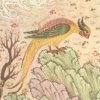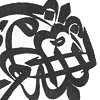 1.7: The Merchant and his Clever Parrot
1.7: The Merchant and his Clever ParrotThere was a certain merchant who kept a parrot in a cage. Being about to travel to Hindustan on business, he asked the parrot if he had any message to send to his kinsmen in that country, and the parrot desired him to tell them that he was kept confined in a cage. The merchant promised to deliver this message, and on reaching Hindustan, duly delivered it to the first flock of parrots he saw. On hearing it one of them at once fell down dead. The merchant was annoyed with his own parrot for having sent such a fatal message, and on his return home sharply rebuked his parrot for doing so. But the parrot no sooner heard the merchant's tale than he too fell down dead in his cage. The merchant, after lamenting his death, took his corpse out of the cage and threw it away; but, to his surprise, the corpse immediately recovered life, and flew away, explaining that the Hindustani parrot had only feigned death to suggest this way of escaping from confinement in a cage.
read a literal
version of the parrot story here
or a poetic version by Coleman
Barks
 1.10: The Tattooed Lion
1.10: The Tattooed LionIt was the custom of the men of Qazwin to have various devices tattooed upon their bodies. A certain coward went to the artist to have such a device tattooed on his back, and desired that it might be the figure of a lion. But when he felt the pricks of the needles he roared with pain and said to the artist, "What part of the lion are you now painting?" The artist replied, "I am doing the tail." The patient cried, "Never mind the tail; go on with another part." The artist accordingly began in another part, but the patient again cried out and told him to try somewhere else. Wherever the artist applied his needles the patient raised similar objections, till at last the artist dashed all his needles and pigments on the ground, and refused to proceed any further.
"Tattooing in Qazwin" by Coleman Barks. here is an excerpt:
In Qazwin, they have a custom of tattooing themselves
for good luck, with a blue ink, on the back
of the hand, the shoulder, wherever.A certain man goes to his barber
and asks to be given a powerful, heroic, blue lion
on his shoulder blade. "And do it with flair!
I've got Leo ascending. I want plenty of blue!"But as soon as the needle starts pricking,
he howls,
"What are you doing?"
"The lion."
"Which limb did you start with?"
"I began with the tail."
"Well, leave out the tail. That lion's rump
is in a bad place for me. It cuts off my wind."The barber continues, and immediately
the man yells out,
"Ooooooooo! Which part now?"
"The ear."
"Doc, let's do a lion with no ears this time."The barber shakes his head, and once more the needle,
and once more the wailing,
"Where are you now?"
"The belly."
"I like a lion without a belly."The master lion-maker
stands for a long time with his fingers in his teeth.
Finally he throws the needle down.
"No one has ever
been asked to do such a thing! To create a lion
without a tail or a head or a stomach.
God himself could not do it!
Before you go on to the next section, make sure you can answer the following questions:
Source: Unless otherwise noted, the readings come from Rumi's Masnavi, translated by E. H. Whinfield (online in pdf format at Omphaloskepsis). This version of the text is provided for your printing convenience. Reading comprehension questions have been added after each section.
|
Modern Languages / Anthropology 3043: Folklore &
Myth. |
|